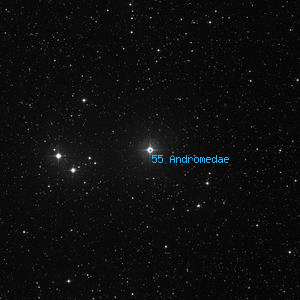55 Andromedae

Overlaid DSS image of 55 Andromedae, 60' x 60' with north at top and west to the right
Aladin viewer for the region around 55 Andromedae
55 And
BD+40 394, HD 11428, HR 543, WDS J01533+4044, SAO 37587, GSC 02820-02261, HIP 8814, Gaia DR3 344400959177254144
BD+40 394, HD 11428, HR 543, WDS J01533+4044, SAO 37587, GSC 02820-02261, HIP 8814, Gaia DR3 344400959177254144
| Type | Star |
|---|---|
| Magnitude | 5.394 | Right Ascension | 1h 53' 17.4" (2000) |
| Declination | 40° 43' 47" N |
| Constellation | Andromeda |
| Classification | K1III |
Observing Notes
Andrew Cooper
Aug 17, 2023 Waikoloa, HI (map)
20cm f/6 Newtonian, Cave Astrola @ 76x
Seeing: 7 Transparency: 7 Moon: 0%
Orange, an 11th magnitude 1' companion not visible though it should be easy! in a field rich in 6th to 9th magnitude stars
WDS lists a B companion 1' north at 10.9 magnitude as listed by John Herschel in 1828, this is reflected in SkySafari, the companion was re-observed in 2010 according to VizieR, looking at the survey images the only star in this position is UCAC4 654-007208 at 13.3 V magnitude, SIMBAD crosses this star as the WDS J01533+4044B component, Gaia data shows this star to be a background star with negligable parallax
Captain William Henry Smyth
Dec 13, 1832 No. 6 The Crescent, Bedford, England (map)
150mm f/17.6 refractor by Tully 1827
A most delicate double star, on the Lady's right leg, about 3° from γ Andromedæ, a little south of the line from that star towards β. A 5½, yellow; B 16, bluish. This is No. 1094 of H.'s Fourth Series, and designated by him "a fine specimen of a nebulous star." It is singular that it was marked nebulous by Flamsteed, in the British Catalogue, perhaps in consequence of some small stars near it. It sometimes had a burred aspect to my gaze, and the companion was only caught by intense attention, and then only by evanescent glimpses, being a minimum visibile for my telescope: its position and distance are therefore only estimated. Is the intense blue which some of these mere points of light present, an optical illusion? Pigott suspected A of variability.
The acolyte of this object being of the last degree of faintness [mag 13.27], it was necessary to apply that singular method of obtaining a view, viz. to avert the eye, and direct it to another part of the field. John Herschel accounts for the success of this stratagem, by supposing the lateral portions of the retina to be less exhausted than the central ones.― A Cycle of Celestial Objects Vol II, The Bedford Catalogue, William Henry Smyth, 1844
Other Data Sources for 55 Andromedae
Nearby objects for 55 Andromedae
1 object found within 120'
| NGC 721 |
Credits...
Drawings, descriptions, and CCD photos are copyright Andrew Cooper unless otherwise noted, no usage without permission.
A complete list of credits and sources can be found on the about page
55 Andromedae